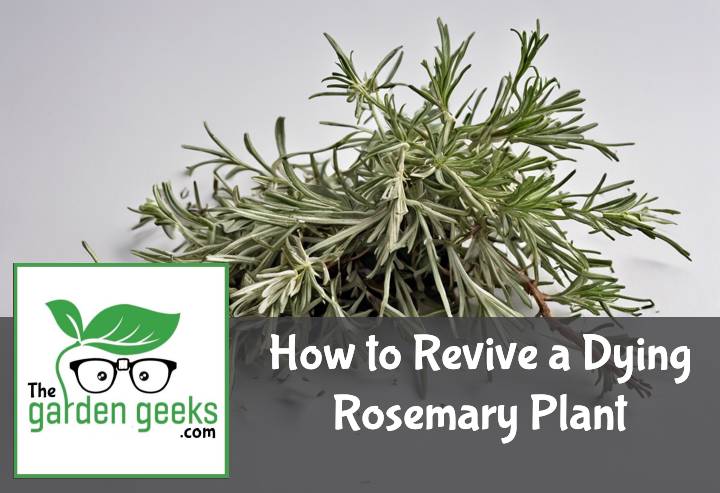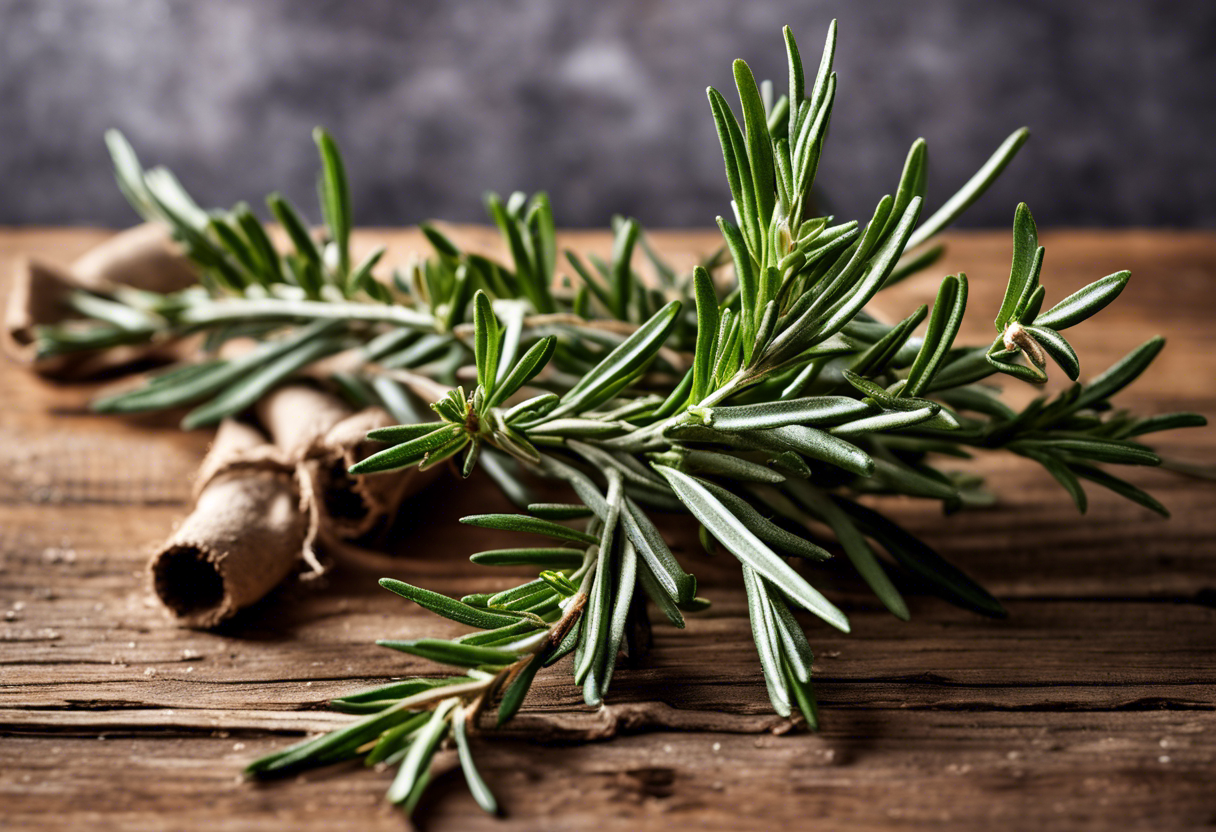Ever found yourself staring at your once vibrant rosemary plant, now looking more like a twiggy relic from the past? You’re not alone. I’ve been there too, wondering How to Revive a Dying Rosemary Plant.
Let’s face it: plants can be drama queens sometimes. But hey, with a little TLC and some handy tips, we’ll have that rosemary sprouting back to life in no time! So buckle up, green-thumb warriors – it’s time for some plant CPR!
Key Takeaways
- Identify the problem with your rosemary plant, which could be overwatering, underwatering, or lack of sunlight.
- If overwatered, allow the soil to dry out completely before watering again.
- If underwatered, water thoroughly until water drains from the bottom of the pot.
- Ensure your plant gets at least six hours of sunlight daily.
- Prune dead branches to promote new growth and consider repotting if the plant is root-bound.
Understanding the Problem
When it comes to How to Revive a Dying Rosemary Plant, knowing what’s wrong is half the battle. It’s like playing detective, but with plants! You need to identify the problem before you can fix it.
Identifying Signs of a Dying Rosemary Plant
So, how do you know if your rosemary plant is on its last legs? Well, there are some telltale signs. If your plant has wilting rosemary leaves or brown rosemary needles, that’s a cry for help.
But wait, there’s more! Is your plant looking a bit droopy? Drooping rosemary branches are another sign of an unhealthy plant. And let’s not forget about discoloration – if your plant has lost its vibrant green hue, it might be time to intervene.
Common Causes for a Dying Rosemary Plant
Now that we’ve covered the signs, let’s talk about causes. One common culprit is water – too much or too little can spell disaster for your rosemary plant. Overwatering and under-watering are both common causes of dying rosemary plants.
But water isn’t the only issue. Disease can also take down your plant faster than you can say “rosemary”. And don’t even get me started on poor soil conditions – they’re like kryptonite for plants! So remember folks, when it comes to reviving your dying rosemary plant, knowledge is power!
Assessing Your Rosemary Plant’s Condition
Before you start the process of How to Revive a Dying Rosemary Plant, it’s crucial to assess your rosemary plant’s condition. You wouldn’t want to give it the wrong treatment, right? It’s like diagnosing an illness before prescribing medicine.
Evaluating the Soil and Root Health
First things first, let’s talk about soil and root health. If your rosemary is looking a bit under the weather, it could be due to poor soil conditions or unhealthy roots.
To evaluate the soil, check if it’s well-draining. Rosemary plants hate waterlogged soil! Also, look for signs of nutrient deficiency like yellowing leaves.
Now onto the roots. Healthy roots in rosemary plants should be firm and white or light brown. If they’re dark brown or black and feel mushy, that’s a red flag! That means your plant is suffering from root rot.
Checking for Pests or Diseases
Next up on our rosemary health check list is pests and diseases. These little buggers can wreak havoc on your beloved plant!
Common pests that love munching on rosemary include aphids, spider mites, and whiteflies. If you notice tiny bugs crawling around or see sticky residue on the leaves – bingo! You’ve got a pest problem.
As for diseases, watch out for powdery mildew and root rot (yes, we mentioned this earlier!). These are typical diseases in rosemary plants that can cause wilting or discoloration.
Remember folks, proper diagnosis is key in learning how to revive a dying rosemary plant!
Reviving Techniques for a Dying Rosemary Plant
So, your rosemary is on the fritz, huh? No worries! We’ve got some top-notch techniques to bring it back from the brink. Let’s dive into how to revive a dying rosemary plant.
Adjusting Watering Practices
First things first, let’s talk about water. You see, rosemary plants are like Goldilocks – they don’t want too much or too little water, but just the right amount. Overwatering can drown them and underwatering can leave them parched.
Signs of an overwatered rosemary include yellow leaves and a wilting appearance. On the other hand, underwatered rosemary symptoms might be brown, crispy leaves. So how do you strike that perfect balance?
Well, establishing a proper rosemary watering schedule is key here. It’s best to let the soil dry out between waterings. When you do water, make sure it’s thorough so that it reaches deep roots.
Modifying Light and Temperature Conditions
Next up on our revival tour is light and temperature conditions. Rosemary plants love their sunbathing sessions. They need at least six hours of sunlight daily to thrive.
If your plant isn’t getting enough light indoors (indoor rosemary care light), consider moving it near a south-facing window or using artificial lights. But remember not to fry your plant with too much direct heat!
Temperature-wise, these Mediterranean natives prefer cooler nights and warmer days – think 60-75°F (15-24°C). If temperatures are off-kilter in your home or garden, adjusting temperature for plants may be necessary.
Improving Soil Quality
Last but certainly not least is soil quality – the bedrock of any healthy plant! The best soil for rosemary plants is well-draining with plenty of organic matter.
Improving garden soil quality can make a world of difference to your plant’s health. Adding organic matter in soil, like compost or well-rotted manure, can boost its nutrient content.
Remember, rosemary needs key nutrients like nitrogen, phosphorus, and potassium for healthy growth. So don’t skimp on the good stuff when it comes to soil!
Treating Pests and Diseases in Rosemary Plants
When it comes to how to revive a dying rosemary plant, dealing with pests and diseases is a biggie. It’s like playing detective, identifying the culprits and then bringing them to justice. Let’s dive into the nitty-gritty of common pests/diseases and how to treat ’em.
Identifying Common Pests and Diseases
First things first, you gotta know what you’re up against. When it comes to rosemary plant care, being able to identify common pests and diseases is half the battle won.
Look out for signs of infestation or disease. If your rosemary looks more like a horror movie set than a healthy plant, chances are something’s up.
For instance, if you spot tiny green critters crawling all over your rosemary, that’s probably aphids making themselves at home. On the other hand, if your plant has black spots or moldy patches, it might be suffering from a fungal disease in rosemary.
Safe and Effective Treatment Methods
Once you’ve identified the problem, it’s time for some action! There are plenty of safe treatments for diseased rosemary plants that won’t harm Mother Nature.
Prevention is always better than cure when it comes to pest control in rosemary plants. Regularly check your plants for any signs of trouble and nip them in the bud (pun intended).
If an infestation or disease does occur, don’t panic! There are organic remedies for rosemary diseases that can help get your plant back on track. For example, neem oil works wonders against aphids and other pesky bugs without harming beneficial insects.
Remember folks, keeping your rosemary happy means keeping it healthy!
Preventive Measures to Keep Your Rosemary Healthy
Let’s face it, folks. Rosemary plant care is not a walk in the park. It requires dedication and a keen eye for detail. But don’t fret! With some simple preventive measures for plants, you can ensure healthy rosemary growth.
Regular Maintenance Tips
Now, let’s talk about regular maintenance. You know what they say, “A stitch in time saves nine.” This couldn’t be more true when it comes to maintaining healthy rosemary.
First off, keep an eye out for any signs of disease or pests. These little buggers can wreak havoc on your precious greenery if left unchecked. Next up, remember to prune your rosemary regularly. This helps promote new growth and keeps the plant looking neat and tidy.
Finally, don’t forget about watering! Rosemary plants love well-drained soil, so avoid overwatering at all costs. Trust me; no one likes soggy feet, especially not our dear rosemary!
Ideal Growing Conditions for Rosemary
Alrighty then! Let’s move on to the ideal growing conditions for our beloved herb. If you want to know how to revive a dying rosemary plant, understanding these conditions is key.
First things first – location, location, location! Rosemary thrives in full sun exposure, so make sure your plant gets plenty of light each day. And remember – too much shade can lead to leggy growth and fewer tasty leaves.
Next up – soil conditions. Rosemary prefers sandy or loamy soil with good drainage capabilities. So if you’re stuck with clayey soil (like yours truly), consider adding some sand or compost to improve its texture.
And there you have it! With these preventive measures and ideal growing conditions in mind, you’ll be well on your way to maintaining robust rosemary health.
To Wrap Up
So, we’ve walked through the rosemary jungle together and now you’re all geared up to bring your wilting buddy back to life. Remember, it’s like nursing a hangover – hydration, good environment and a little TLC are key.
Don’t let your rosemary turn into a dried herb in your spice rack! Check out our guide on How to Revive a Dying Rosemary Plant for more tips. Keep those green thumbs working!





